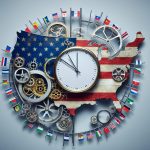The stock market experienced a dramatic plunge on Friday, with the Dow Jones Industrial Average falling more than 2,200 points. The sell-off was triggered by heightened trade-war fears after China announced retaliatory tariffs against U.S. goods, following President Trump’s sweeping tariff announcement earlier this week. The Dow fell 5.5% to enter correction territory, while the S&P 500 nearly sank 6%, marking its worst week since the market turmoil of 2020.
The tech-heavy Nasdaq Composite dropped 5.8%, closing in bear market territory. China said it will impose additional tariffs on all U.S. products starting April 10, matching the extra 34% duties imposed by Trump on Wednesday. This announcement intensified investor fears of a prolonged global trade war.
Federal Reserve Chair Jerome Powell warned of higher inflation and slower growth stemming from the tariffs, further spooking investors. Investors flocked to the safety of government bonds, causing the yield on the 10-year Treasury to fall to 3.9%, nearing its lowest levels since October. Despite the volatility, the labor market showed resilience.
Trade fears trigger mass sell-off
The U.S. added 228,000 jobs in March, exceeding estimates, although the unemployment rate ticked up to 4.2%. Treasury Secretary Scott Bessent defended Trump’s economic policies, attributing the market decline to other factors, including recent concerns over artificial intelligence advancements from Chinese startup DeepSeek.
The market rout saw significant declines among major tech stocks. Nvidia shares fell 8%, while Tesla tanked 10%. Investors’ concerns over a potential recession led to a broad market sell-off.
Bitcoin, however, showed some resilience, hovering above $84,000 as some investors moved to the digital asset amid the equity sell-off. GameStop also saw a notable surge in stock price after CEO Ryan Cohen’s significant share purchase was disclosed. Several IPOs, including those of StubHub, Klarna, and Chime, have been delayed as the market turbulence continues.
Amid the economic chaos, Federal Reserve Chair Jerome Powell quipped during a Q&A session about his preference for purple ties, explaining it as a symbol of Fed independence. As the trading week concluded, the overall sentiment remained one of caution and concern, with market participants closely watching for further developments in the ongoing trade conflict between the U.S. and China.







